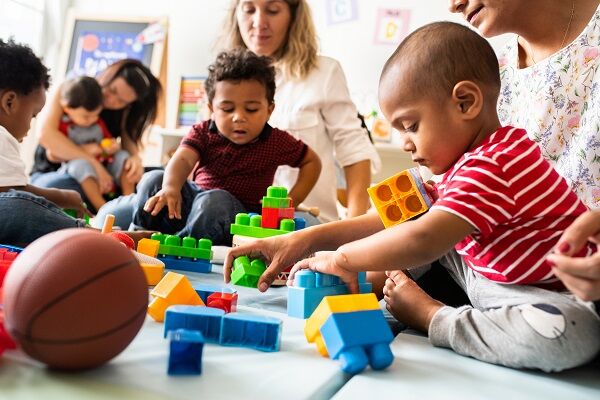Stress
Will Social Distancing Affect My Toddler’s Development?
Child care was a place for learning and much needed parental breaks.
Posted May 22, 2020 Reviewed by Lybi Ma
Ah, child care. It brought runny noses and sniffles, but also needed parental breaks and important connections and learning. Many parents whose young children were thriving in group child care settings before COVID-19 may be wondering if child care closures and physical and social-distancing will influence their child’s development. If a baby or toddler used to go to child care or spend time with other adults, things probably feel very different now. Daily life may also feel a lot more stressful for parents—more on that in a minute.

A new normal
Parents might be wondering if this new way of life and being removed from regular routines, extended family, and friends are impacting their child’s social skills and brain development. Luckily, it doesn’t have to. Brain development will maintain a healthy trajectory if babies have at least one primary caregiver who remains attentive, engaged, and can ensure a safe, stable, and nurturing environment. While children may miss their other caregivers, extended family members, and friends, their social skills can continue to develop in a healthy way as long as parents stay engaged, keep stress manageable, and provide opportunities for age-appropriate interactive moments.
How can parents help?
It’s understandable that parents might be worried about their children’s development right now. But they can be assured that an attentive adult is all a baby needs. Moms, dads, and other primary caregivers have umpteen (it’s official) facial expressions, many ways to smile and show interest, and extensive vocabularies to share with their little ones. Parents can do a lot to ensure their little ones at home keep learning and growing. Things parents were doing before such as reading books, singing songs, and talking with baby are still relevant, except now there may be many more opportunities to interact like this throughout the day. We often use the sportscaster metaphor to describe how parents can narrate their daily activities to baby. Parents can still get things done and literally talk their way through the day, for example: “Now I’m making rice. Here’s the pot and here is a cup of water and a half cup of rice. I’m putting the cover on and setting the timer so it can cook.”
Parents really can give a baby everything they need. However, the COVID-19 crisis has many of us feeling plenty of additional stress. That additional stress can affect our ability to provide attentive, responsive caregiving.
How can parents mitigate stress?
The bad news is that increased anxiety and stress in parents (whether related to the pandemic or not) can have a negative impact on young children. There are many different kinds of stress: toxic stress, which is chronic and unmitigated, and then tolerable and even positive stress. While children can grow and learn from positive stress (and even tolerable stress if it’s not too frequent), toxic stress can derail child behavior and brain development, especially for infants and toddlers whose brains are extra sensitive and disproportionately receptive to input. Those infant brains are like sponges, and they soak it all up, the good and the not-so-good. Because caregiver stress impacts child stress, it’s important for adults to take steps to reduce stress and care for themselves in as many ways as possible. Parents—especially now—need resources, respite, and support to navigate the current situation. Mindfulness is also a practice that can lengthen a caregiver’s fuse, allowing them to stay calm while interacting with and meeting the needs of young children.
When can we get back to actual socializing?
Some parents are struggling to keep themselves emotionally regulated in the absence of frequent adult-to-adult interactions. Video conferencing and phone calls aren’t the same, but they can help impact the isolation. Unfortunately, because this coronavirus has brought a new normal to all of us, which seems to change weekly, it’s hard to figure out when and how you might be able to safely interact with people outside your own household. That decision will be personal and determined by many factors including the health of your family members. However, as a guideline, “outdoors tends to be better than indoors, small groups are better than large groups and a shorter period of time is better than a longer one.” (Netburn, D., 2020).
Remember, there are many cultures in the world where infants stay close to one primary caregiver for the entire first year, many families that live in isolated places by choice, and many children who thrive in all of these settings.
Sarah MacLaughlin, LSW, contributed to this post. Sarah is a social worker, parent educator, and author of the award-winning, bestselling book, What Not to Say: Tools for Talking with Young Children.
Facebook image: anatoliy_gleb/Shutterstock
References
Netburn, D. (2020, May 16). So you really want to see your friends? Here’s how to assess the risk. Los Angeles Times. Retrieved from https://www.latimes.com/science/story/2020-05-16/so-you-really-want-to-…?


